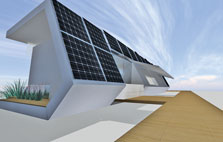

The Kansas home, with its solar-panel facade announcing its use of renewable energy, is truly mobile, fitting largely on one truck, setting back up in hours, and taking only eight days to build in the first place.
Download Construction Drawings
(Zip 20 MB)
Neither the United States, nor the Department of Energy, nor the Alliance for Sustainable Energy LLC, nor any of their contractors, subcontractors, or their employees make any warranty, express or implied, or assume any legal liability or responsibility for the accuracy, completeness, or usefulness for any purpose of any technical resources or data attached or otherwise presented here as reference material.
Solar Decathlon 2007
Kansas Project Solar House
(Kansas State University and University of Kansas)
Zero Energy Technology Rolls across the Prairie
"Go mobile"—one of five points in the Kansas team's mission statement—gives a good start at characterizing this home. Transporting their homes to Washington, D.C., is a major challenge for many of the teams, but the virtually fully assembled Kansas entry fits on one truck.
"It can be unloaded from the truck and set up in a matter of hours," says engineering student Brad Lutz. "On the way back from D.C., we will be stopping at major Kansas cities to display the home."
The home's extensive use of structural insulated panels makes it very "low labor." "We were able to build the home in just eight days," says architecture student Matt Teismann. The narrow shape is ideal for showing off its efficiency and renewable energy features. A facade of solar panels easily attached to standing-seam metal roofing covers most of the south wall, right at eye level and tilted at 64° to maximize winter sun. Three additional sets of panels on the roof are mounted on two-axis tracking systems to maximize energy capture.
Another point in the Kansas mission statement is to "redirect expectations," and the home challenges visitors to do just that. It demonstrates that you don't necessarily need heat or artificial lighting for common household tasks. The centrifugal clothes dryer uses a fraction of the energy of a conventional heated dryer. An induction cooktop heats only the cookware and the food inside it, never getting hot to the touch. A mix of daylighting and indirect fluorescent lights provide most of the light, with only a few LED can lights for task lighting. A key task for the home's sophisticated utility monitoring and control system is to know what systems to turn off first if the energy supply is tight. As a backup though, batteries hold three days worth of energy.
Team Contact
R. Todd Gabbard
rtodd@ksu.edu
